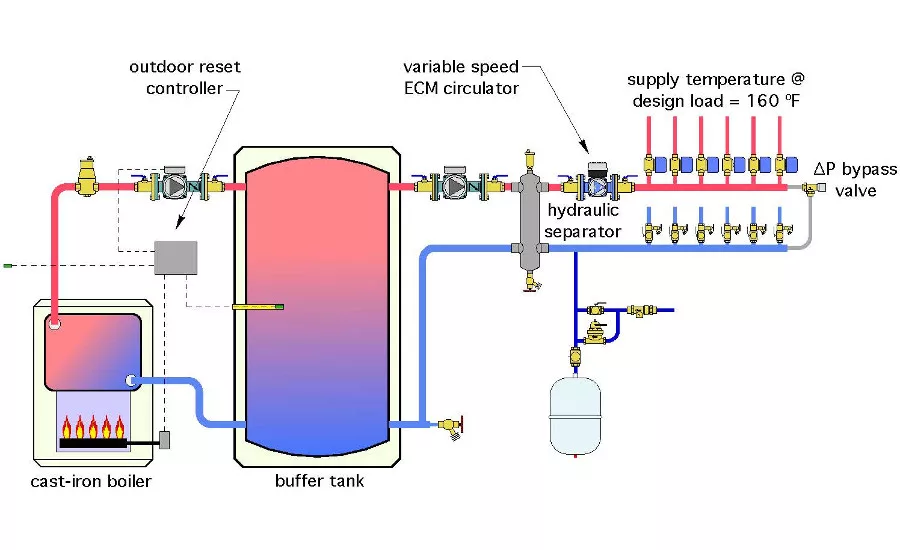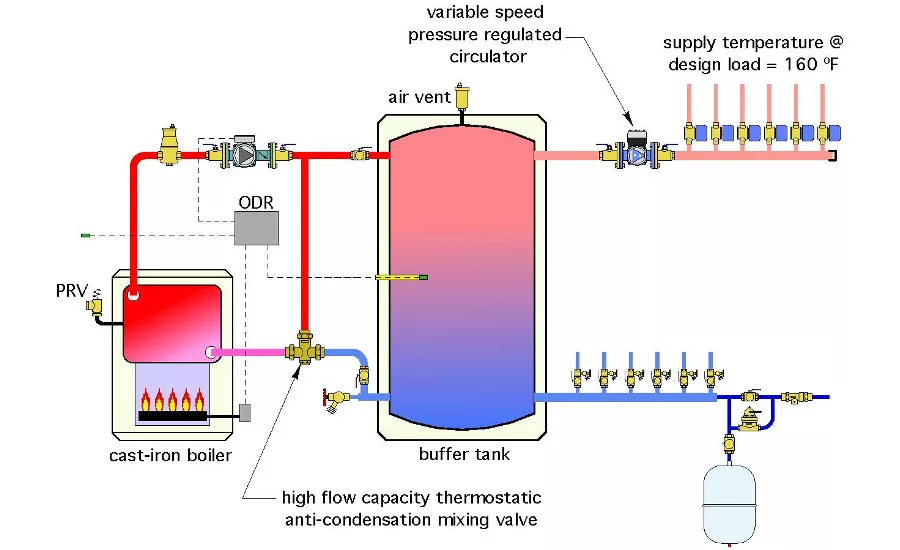Double Duty

The Glitch. A schematic for the proposed system is shown in Figure 1.

The Fix. First, it is not necessary to use both a buffer tank and a hydraulic separator as shown in Figure 1.
The Glitch:
A heating contractor is asked to create a multi-zone system that will supply 160 ºF water to several zones of heat emitters at design load conditions. A conventional cast-iron gas-fired boiler will be used. Because of the extensive zoning, the contractor decides to use a buffer tank between the boiler and zone circuits to prevent boiler short cycling. A hydraulic separator is also selected to isolate the pressure dynamics created by the variable speed circulator from those created by the other circulators in the system. To maintain stable room temperature, the water temperature delivered from the buffer tank will vary based on outdoor reset control.
A schematic for the proposed system is shown in Figure 1 below.
Can you identify several errors or suggest some more refined design approaches for this system?
Figure 1:
 The Fixes:
The Fixes:
There are several ways to refine this system and still provide smooth heat delivery and stable hydraulic performance.
First, it is not necessary to use both a buffer tank and a hydraulic separator as shown in Figure 1. A buffer tank, when properly piped, can provide both buffering and hydraulic separation. The key is to keep the headers on the load side of the tank short and generously sized. The flow resistance through these headers, combined with extremely small head loss through the buffer tank separates the pressure dynamics of the variable speed circulator from that of the boiler circulator. The hydraulic separator as well as the circulator between it and the buffer tank can be eliminated.
2. A differential bypass is not needed, nor should it be present in a system where differential pressure is controlled by a variable speed circulator. If a differential pressure bypass valve is already present, it should be fully closed.
Figure 2:

3. Although the water temperature returning to the boiler under design load conditions should be high enough to prevent sustained flue gas condensation, this will not be the case under low load conditions. Thus, the conventional boiler should be protected against sustained flue gas condensation by a high flow capacity 3-way thermostatic mixing valve, or other anti-condensation detailing. Some outdoor reset controllers have a minimum supply water temperature settings that is intended to prevent flue gas condensation, but using this feature limits how low the water temperature supplied to the heat emitters can be. This compromises the stable interior comfort benefits offered by “full range” outdoor reset control.
Other changes include:
4. Adding a float type air vent to the top of the buffer tank.
5. Adding a pressure relief valve to the boiler.
Check out Double Duty in pdf form
Looking for a reprint of this article?
From high-res PDFs to custom plaques, order your copy today!









